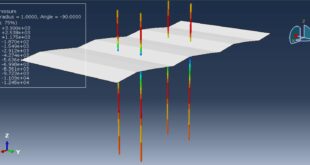Simulation CFRP for seismic strengthening of shear controlled RC column in Abaqus has been studied in this tutorial. The concrete column is modeled as a three-dimensional solid part, the steel reinforcements are modeled as three-dimensional wirt part, and the CFRP is modeled as a shell part. You can see a figure of the assembled parts below

Recent post-earthquake surveys revealed the high vulnerability of existing Reinforced Concrete (RC) structures, often designed for gravity loads only, even to moderate seismic events. Indeed, the lack of a proper seismic detailing and a wrong shear-flexure hierarchy often lead to columns brittle failures due to shear before attaining theflexural yielding. Furthermore, short and wall-like RC columns are commonly subjected to such a brittle failure, governed by concrete diagonal compression failure. To prevent premature brittle failures of existing RC columns, the use of Externally Bonded Reinforcement (EBR) made of Fibre Reinforced Polymer (FRP) strips has been recognized as a reliable and cost saving strategy for increasing members lateral strength capacity. Plenty of researchers focused the attention on the shear strengthening of RC beams, mainly due to gravity loads de-ficiencies. Even though post-earthquake observed shear failures in columns are more diffused than shear failures of beams
To model seismic behavior of concrete, the Concrete Damaged Plasticity(CDP) material is selected to consider tension nd compression damage. The CFRP reinforcement is model as elastic material that can damage model also is available. The general static step is appropriate for this type of analysis. All contact, constraints, cyclic loading boundary, and meshes are assigned
After the simulation, all results such as stress, strain, tension and compression damage, CFRP displacmeent, Hysteresis diagram, and others are available. You can see some figures for the results below








 Abaqus tutorials Abaqus tutorials
Abaqus tutorials Abaqus tutorials




